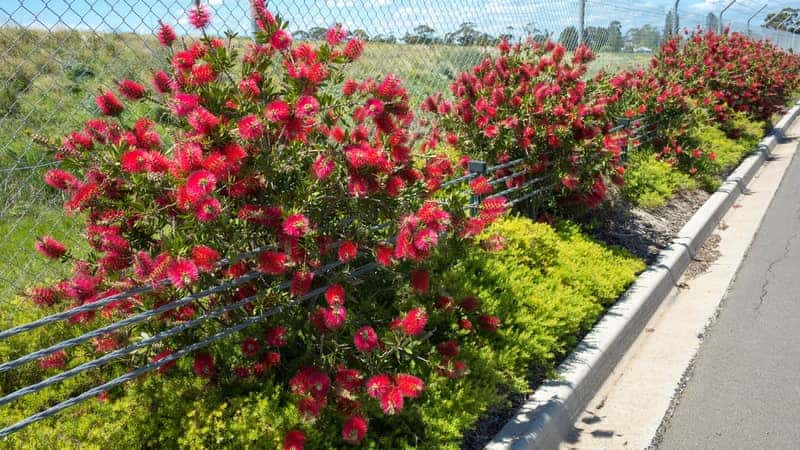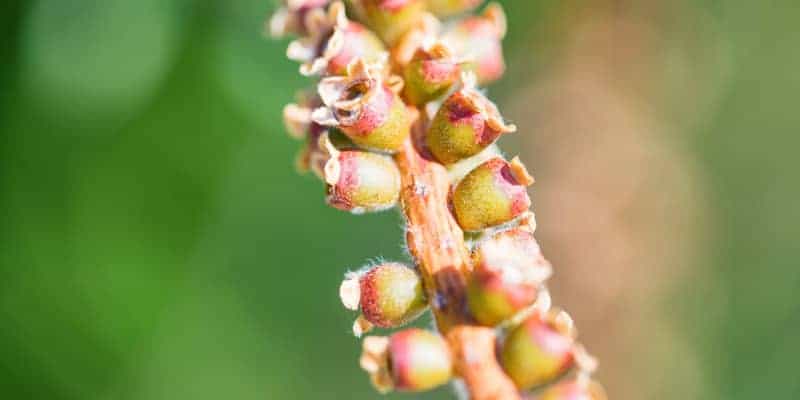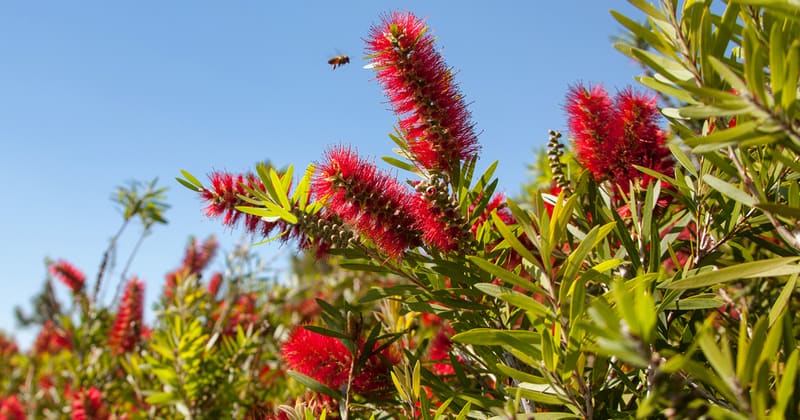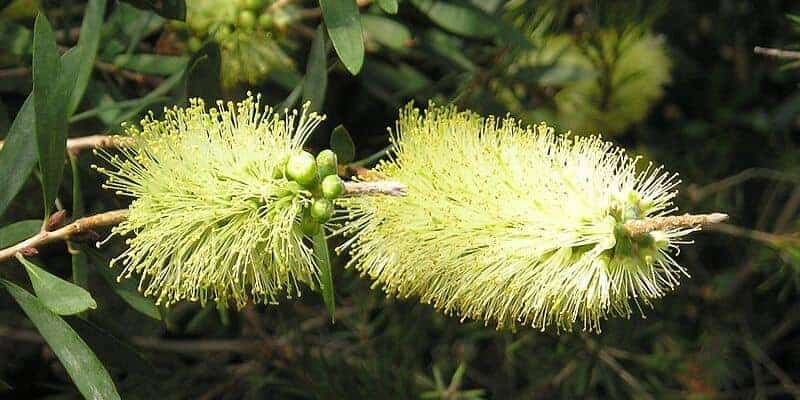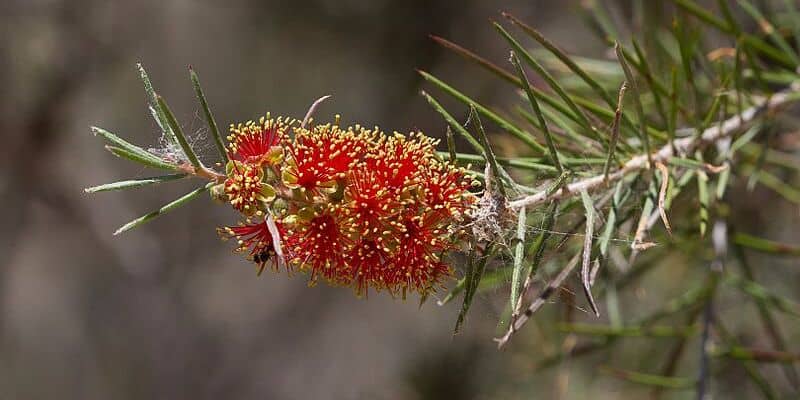Those of us with brown thumbs, rejoice! You can still have gorgeous, colourful flowers in your garden. The bottlebrush (Callistemon viminalis) is low-maintenance and difficult to kill. It’s also one of many Australian native flowers, making it perfect for any local garden!
Growing bottlebrush is very straightforward. Plant your small trees anywhere with full sun (although the plants will tolerate part shade). Young plants need regular watering, while mature plants are drought-tolerant. The Callistemon prefers moist soils, but will tolerate many soil types, even salty ground. Cultivate bottlebrush anywhere except in regions with frost.
Whether you forget to water these plants or accidentally water too much – your shrub can take it. Fill your garden with colour by growing bottlebrush plants using our handy guide.
Bottlebrush 101
Bottlebrush flowers are Australian native plants, growing in many places across the country. They’re named after the shape of the flower spikes, which resemble brushes for cleaning bottles.
Callistemon spp. itself derives from the Greek words “kallos” (beauty) and “stemon” (stem). They describe the coloured flower spike or stamen. The plant belongs to the genus Callistemon, with 40 identified species so far.
Bottlebrush (Callistemon) thrives mainly in east and southeast Australia, although it can be found anywhere from the tropical north to the temperate south. It often grows in damp conditions such as creek beds or flood-prone areas.
The plant grows either as a small tree (4m on average) or a large shrub (1–2m). It’s commonly used for hedging or as a street tree.
The Callistemon is a fast-growing, attractive shrub perfect for any Australian garden. The most common plant is the Crimson bottlebrush, which has stunning dark red flowers. However, these days, flower colours range from red to pink to cream, and even green.
If you grow Callistemon, be ready to befriend your local wildlife! The bottlebrush tree attracts many nectar-feeding birds and bees to your garden.
Bottlebrush Growing Conditions
Callistemon likes full sun, but can tolerate up to partial shade. However, you’ll need to maximise sunlight to get the most flowers.
Many species thrive in damp conditions (not waterlogged!), but are very hardy and will tolerate drought. They grow well in most soils except those that are highly alkaline.
Apply a low phosphorus fertiliser in spring and autumn to encourage new growth. You can also layer organic mulch around the base (without touching the trunk!) to help retain soil moisture and reduce weeds.
How to Grow Bottlebrush
You can grow bottlebrushes in one of three ways:
- From seed
- From cuttings
- From a young plant
Each method is simple – the only difference is the time it takes for the plant to grow and mature. Growing from seed will take the longest.
You can propagate bottlebrushes either in a garden or in a pot.
1. Growing bottlebrush from seed
Collect unopened fruits, then store them in a paper bag. Place the bag somewhere warm and wait until the fruit releases its seeds. This can take several days, so be patient!
Once the seeds have been released, you can germinate them as you would any other plant seeds. Fill a small pot with soil, then loosen the top later and moisten it. Sow bottlebrush seeds directly onto the surface and water immediately after.
Keep the seeds and soil warm during germination. They should sprout within two weeks.
Transfer the pot to a sunny location that gets at least 6 hours of direct sunlight. Water regularly while the seedlings grow, then slowly taper off the watering as they mature.
2. Propagating bottlebrush from cuttings
To take a bottlebrush cutting, trim a stem that is 25–30cm long, just above a joint. This is best done in late summer. Cut at an angle, just like a flower. Place the cut end immediately in a glass of water.
Fill a pot with a mixture of equal parts peat moss and sand. Use a dowel to make an indentation about 10–12cm deep.
Dip the cut end into rooting powder to help with its new growth. Then place the cutting into the hole in the pot. Use your fingers to pat down the soil so that the cutting is secure.
Water just enough to moisten the soil. Peat moss retains moisture, so be wary of overwatering. Place the cutting somewhere out of direct sunlight, in an area about 20–24ºC.
In about six weeks, your cuttings should be ready to transplant into individual pots or a garden bed.
3. Planting bottlebrush
Choose a location in your garden that gets full sun – at least 6 hours a day.
Dig a planting hole that’s twice as wide and the same depth as the root ball.
Remove the plant from its container and gently tease the roots. Trim away any circled or tangled roots.
Position the plant in the hole and gently backfill, carefully firming down the soil as you go. Water well to settle the soil and keep it moist for several weeks.
You can mulch around the base so long as you keep it away from the trunk.
Pruning Bottlebrush
A light prune after flowering will encourage new growth and blooms. Remove flower spikes once the display has finished by snipping off flowerheads at the base. This will help keep your bottlebrush plant compact and attractive.
If you’re uncertain about when or how to prune your Callistemon, a professional garden maintenance service can take care of your plant for you!
Pests and Diseases
Many Callistemon viminalis species can suffer an occasional attack by:
- Scale insects
- Thrips
- Sawfly larvae
Any of the three pests cause considerable damage to the leaves and stems – either by badly disfiguring the foliage, or defoliating the tree completely. If you suspect a pest infestation, call a local horticultural advisor or gardening service immediately to handle the problem.
Types of Bottlebrush Plants
There are no “best bottlebrushes,” really – all flower colours of Callistemon viminalis are beautiful. Choose a variety that’s common to your area or that will thrive in your garden conditions. You can consult your local nursery or gardening service for suggestions!
Crimson bottlebrush (or, Callistemon citrinus)
This widely-cultivated shrub is possibly the best-known of bottlebrushes. You’ll recognise its bright red flower spikes in summer and autumn. The shrub can reach 4m in height, even in wet conditions. Crimson bottlebrush needs light pruning after flowering, and can take a hard pruning for shaping.
Willow bottlebrush (or, Callistemon salignus)
Also known as “white bottlebrush”, this is a small tree that blooms in white flowers. It is moderately frost-sensitive and prefers moist soils.
Lemon bottlebrush (or, Callistemon pallidus)
This is a hardy species that can tolerate frost, meaning it grows well in most conditions. Still, it flowers best in full sun. The plant is called “lemon” because of its yellow-coloured flowers that bloom in the summer.
Little John (or, Callistemon viminalis)
This is a dwarf Callistemon variety with attractive blue-green foliage. However, Little John can be reluctant to flower. You can opt for the Better John™ variety that produces small red flowers from September to November.
Weeping bottlebrush (or, Callistemon viminalis)
Weeping Callistemon is a large shrub that can reach 8m high if not maintained. It flowers from late spring to autumn, and its blooms attract many nectar-feeding birds. Young plants tend to be frost-sensitive, but can tolerate a spectrum of soils.
Alpine bottlebrush (or, Callistemon pityoides)
This is another hardy Callistemon variety, which grows into a compact bush about 1m tall. In spring and summer, this plant bursts into yellow bloom. As the name suggests, the Alpine bottlebrush is frost-hardy. It can also tolerate heavy pruning.
Prickly bottlebrush (or, Callistemon brachyandrus)
You might be able to tell – this shrub has prickly leaves. It grows to about 3m tall in a rounded shape. Prickly bottlebrushes thrive in hot, dry conditions and well-drained soil. When it flowers, the tips of the bright red flowers are covered in yellow pollen.
Kingaroy bottlebrush (or, Callistemon formosus)
The Kingaroy variety is best for tropical areas without any frost. The shrub can reach 3m in height, with weeping branches. It blooms in lemon-coloured flower spikes throughout the year. You can find this bottlebrush as a street tree in Kingaroy, Queensland.


